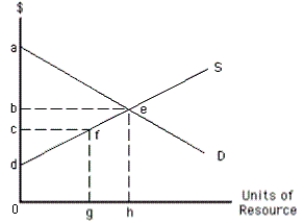A) average resource cost
B) marginal resource cost
C) marginal product
D) marginal revenue product
E) average revenue product
Correct Answer

verified
Correct Answer
verified
Multiple Choice
If two resources, such as labor and farm machinery, are complementary,
A) one can be used in place of the other
B) an increase in the price of one will increase the demand for the other
C) an increase in the price of one will increase the supply of the other
D) a decrease in the price of one will increase the productivity of the other, which will decrease the demand for that other resource
E) a decrease in the price of one will increase the demand for the other
Correct Answer

verified
Correct Answer
verified
Multiple Choice
A resource that earns only economic rent
A) cannot be employed in any other line of production, so its opportunity cost is zero
B) is rental payment for a resource that has already been paid for
C) is impossible because all resources have an opportunity cost associated with their use
D) is not fixed in quantity
E) has a perfectly elastic supply curve
Correct Answer

verified
Correct Answer
verified
Multiple Choice
NARRBEGIN: Exhibit 11-10
Exhibit 11-10
 -Exhibit 11-10 shows data on watch production. If the marginal resource cost is constant at $18 per unit of labor, how many workers should the firm hire to maximize its profit?
-Exhibit 11-10 shows data on watch production. If the marginal resource cost is constant at $18 per unit of labor, how many workers should the firm hire to maximize its profit?
A) one
B) two
C) three
D) four
E) five
Correct Answer

verified
Correct Answer
verified
Multiple Choice
Consider two resource markets in which the demand curves slope downward. In market A, the supply curve is horizontal, equilibrium price is $6, and 100 units of the resource are hired. In market B, the supply curve is vertical, equilibrium price is $20, and 30 units of the resource are hired. Which of the following is true?
A) All of the resource earnings in market A are opportunity costs.
B) All of the resource earnings in both markets are opportunity costs.
C) All of the resource earnings in market B are opportunity costs.
D) None of the resource earnings in either market is an opportunity cost.
E) None of the resource earnings in either market is economic rent.
Correct Answer

verified
Correct Answer
verified
Multiple Choice
Marginal revenue product is defined as the
A) change in total output that results from the employment of an additional unit of a resource
B) change in total product that results from the employment of an additional unit of a resource
C) change in total revenue that results from the employment of an additional unit of a resource
D) change in resource employment that results from a change in total output
E) change in marginal revenue that results from a change in the employment of an additional unit of a resource
Correct Answer

verified
Correct Answer
verified
Multiple Choice
Resource price differentials that trigger the reallocation of resources so as to equalize payments for similar resources are known as
A) permanent differentials
B) trigger price differentials
C) reallocation differentials
D) equal differentials
E) temporary differentials
Correct Answer

verified
Correct Answer
verified
Multiple Choice
Permanent differentials in resource prices will cause
A) all of the following
B) the allocation of fewer resources to lower-paid uses
C) the equalization of payments for the same resource in different uses
D) no change in the allocation of resources
E) the allocation of more resources to higher-paid uses
Correct Answer

verified
Correct Answer
verified
Multiple Choice
NARRBEGIN: Exhibit 11-5
Exhibit 11-5
 -In Exhibit 11-5, total earnings by the resource in equilibrium is represented by area
-In Exhibit 11-5, total earnings by the resource in equilibrium is represented by area
A) 0deh
B) bed
C) dcf
D) 0cfg
E) bed + 0deh
Correct Answer

verified
E
Correct Answer
verified
Multiple Choice
If coal and oil are substitute inputs in the production of electricity, an increase in the price of oil
A) will increase the demand for coal
B) will reduce the demand for coal
C) will increase the supply of coal
D) will reduce the supply of coal
E) will not affect the demand for coal
Correct Answer

verified
Correct Answer
verified
Multiple Choice
NARRBEGIN: Exhibit 11-1
Exhibit 11-1
 -In Exhibit 11-1, which unit of the resource is earning the least economic rent?
-In Exhibit 11-1, which unit of the resource is earning the least economic rent?
A) the fifth
B) the tenth
C) the fifteenth
D) the twentieth
E) they are all earning the same economic rent
Correct Answer

verified
Correct Answer
verified
Multiple Choice
If the marginal revenue product of the fifth worker is $15, the price of the last unit of output produced is $5, and the firm sells as a price searcher, then the marginal product of the fifth worker is
A) 3 units of output
B) 45 units of output
C) fewer than 3 units of output
D) greater than 3 units of output
E) greater than 75 units of output
Correct Answer

verified
D
Correct Answer
verified
Multiple Choice
NARRBEGIN: Exhibit 11-5
Exhibit 11-5
 -In Exhibit 11-5, economic rent in equilibrium is represented by area
-In Exhibit 11-5, economic rent in equilibrium is represented by area
A) abe
B) befc
C) gfeh
D) cdf
E) bed
Correct Answer

verified
Correct Answer
verified
Multiple Choice
If the price of a resource increases, other things constant, less of that resource will be hired because
A) producers will substitute away from that resource
B) producers fear starting a trend toward higher resource prices
C) the demand curve for the product will shift to the left
D) highly paid resources don't produce as much
E) it makes other resources look expensive as well
Correct Answer

verified
A
Correct Answer
verified
Multiple Choice
Which resource earns the highest economic rent as a proportion of total earnings?
A) a resource specialized in one task
B) a nonspecialized resource
C) a resource with inelastic demand
D) a resource in low demand
E) a resource with elastic demand
Correct Answer

verified
Correct Answer
verified
Multiple Choice
When the U.S. housing market slumped from 2005 to 2007, we would expect the demand curve for lumber
A) exhibited a movement along to the right
B) shifted to the left
C) exhibited a movement along to the left
D) shifted to the right
E) None of the answers is correct.
Correct Answer

verified
Correct Answer
verified
Multiple Choice
Along the supply curve of lifeguards at local public pools,
A) the wage paid to lifeguards is held constant
B) the number of lifeguards is held constant
C) the wage paid to lifeguards at private clubs is held constant
D) the demand for lifeguards is assumed constant
E) the admission price to these public pools rises as the wage rate for lifeguards increases
Correct Answer

verified
Correct Answer
verified
Multiple Choice
NARRBEGIN: Exhibit 11-9-1
Exhibit 11-9
 -How low would the wage rate have to fall before the firm in Exhibit 11-9 would hire nine workers?
-How low would the wage rate have to fall before the firm in Exhibit 11-9 would hire nine workers?
A) $198
B) $4
C) $396
D) $28
E) The firm would have to be paid to hire nine workers.
Correct Answer

verified
Correct Answer
verified
Multiple Choice
Consider two resource markets in which the demand curves slope downward. In market A, the supply curve is horizontal, equilibrium price is $6, and 100 units of the resource are hired. In market B, the supply curve is vertical, equilibrium price is $20, and 30 units of the resource are hired. Which of the following is true?
A) All of the resource earnings in market A are economic rent.
B) All of the resource earnings in both markets are economic rent.
C) All of the resource earnings in market B are economic rent.
D) None of the resource earnings in either market is an opportunity cost.
E) None of the resource earnings in either market is economic rent.
Correct Answer

verified
Correct Answer
verified
True/False
For a resource in a perfectly competitive market, marginal revenue product is equal to the price of the resource.
Correct Answer

verified
Correct Answer
verified
Showing 1 - 20 of 216
Related Exams